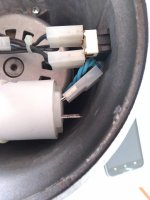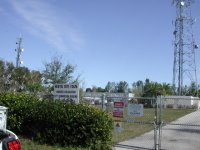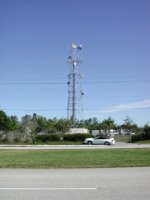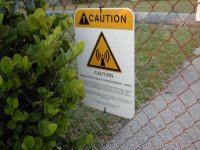Repaired the coffee grinder yesterday.
I was horrified when I opened the bottom. this is Macap commercial grinder, that is motor start cap with 240V on the terminals, and to make matters worse the cap is held in place with a cable tie. I removed the cap bent and heat shrinked the bare terminals.
I was horrified when I opened the bottom. this is Macap commercial grinder, that is motor start cap with 240V on the terminals, and to make matters worse the cap is held in place with a cable tie. I removed the cap bent and heat shrinked the bare terminals.
Attachments
Hi George,
It's more than $700 here to fix that mistake / stupidity. I trained technicians fresh out of various puzzle factories. You're right, many had never even held a soldering iron! How could they release this level of ill-prepared people on the trades?
In my view, basic skills are the job of a school to teach. Apart from my hobby, I was taught about different joints and soldering in grade 10 - before they let us do anything else.
-Chris
It's more than $700 here to fix that mistake / stupidity. I trained technicians fresh out of various puzzle factories. You're right, many had never even held a soldering iron! How could they release this level of ill-prepared people on the trades?
In my view, basic skills are the job of a school to teach. Apart from my hobby, I was taught about different joints and soldering in grade 10 - before they let us do anything else.
-Chris
Hi warrjon,
Pretty scary grinder there. How did that make you feel realizing you used it a lot, and probably shaking it as it ground the beans?
-Chris
I'm an old tech, been fixing electronics for 40 years and never seen anything like it. I use it at least 6 times a day for 5 years, ouch. or luckily no ouch.
measure the harmonics on a 5 watt radio by connecting it directly to a spectrum analyzer and transmitting.....a $700 repair.
It's more than $700 here to fix that mistake / stupidity.
Retail repair, yes $$$$. This happened in the late 80's, inside Motorola where there was an in house cal lab, so the cost to the engineering department that brought in the dead analyzer was for the parts only....and fortunately the attenuator sacrificed itself in order to save the mixer, which would have been more expensive.
Stupidity? No, in this case we had a newly minted "engineer" fresh out of UF, a well respected school. He was never taught what +20 dbm MAXIMUM really meant, although a little thinking, or yet, asking someone who had done it before, how to do it would be a good idea. Just sticking a 30 dB pad between the radio and analyzer would be the obvious choice, and would have saved the $700, but it will give the WRONG answer. You must also use a high pass or notch filter between the pad and the analyzer to knock down the fundamental, or harmonics will be created in the analyzer itself.....after all that mixer IS a nonlinear element, and we were looking at a -80 dB maximum harmonic spec out to the tenth harmonic. Levels beyond the third are in the -100 dB or better range. That is NOT taught in ANY engineering school
You're right, many had never even held a soldering iron! How could they release this level of ill-prepared people on the trades?
There is a whole lot about engineering that MUST be learned by doing, and doing again. The techniques learned in "advancing the state of the art in RF communication" must be documented and shared among ALL involved. Much WAS documented, but some of the details of testing, and some spectacular failures existed only in the memories of the few "old timers" that lived through some of those events in the past.
That's one of the reasons I lasted 41 years in that place, and conned the management into a few "field trips" to NFL and MLB games.....the stadium was right next to the antenna farm for all of south Florida's TV stations. 13 transmitters each blasting out 1 MEGAWATT ERP plus several lower powered channels will create a real world "worse case" test system!
Here's a picture that I used in a report I called "The Two Towers." It's a multiple cellular site. The west facing antennas were at or above the legal maximum ERP at the time to cover a good chunk of the Florida Everglades swamp. That's my Mustang with the trunk open. I got questioned several times by cops when they saw me wandering in the cow pasture with fancy cop radios better than the ones they had.....yes, there is a 1 million square foot Motorola plant 4 miles from here, and yes, we make cop radios.....Mine don't transmit, but they do hear all your calls!...…
And YES, I could actually measure IMD signals being generated by the rusty chain on the gate which had been replaced in this picture. They don't teach THAT in engineering school either. I had actually discovered something similar at the age of 17 while putting up TV antennas. That loose ground wire with the green growth on it made channel 7 disappear by creating harmonics from the ultra strong channel 6 tower nearby.
Attachments
It's not clear, but is that outer casing made of metal?
Yes cast aluminium.
Retail repair, yes $$$$. This happened in the late 80's, inside Motorola where there was an in house cal lab, so the cost to the engineering department that brought in the dead analyzer was for the parts only....and fortunately the attenuator sacrificed itself in order to save the mixer, which would have been more expensive.
My last job was in the repair dept of a military cal lab. I used to repair and cal a lot of Agilent spectrum analyzers it was amazing how many needed the input attenuator replacing.
Hi George,
When I went to Ryerson, I took instrumentation courses and they were careful to go over that material. They also went over things like crest factor and a bunch of practical, real world stuff. One message that was delivered was, if you aren't sure about someone, ASK.
I had a torture site as well. Not nearly as dramatic as yours mind you. I had a site where within 1 km, there are two AM radio transmitters at 50 Kw each. One at 1.01 MHz and the other at 1.05 MHz. I think the field strength was around 3 V per meter, it varied quite a bit depending on where you were.
This field caused some ports on the digital phone system to malfunction, and the paging horns would play one or the other station depending. Each horn needed a filter, as did the output of the paging amps. Thank goodness they were transformer coupled and that kept the RF out of the amp. They had problems with the computer network and instrumentation sensors and amps. Most of the wiring was underground in the tunnels. The phone system was an eOn Millenium, so it was a solid system.
-Chris
When I went to Ryerson, I took instrumentation courses and they were careful to go over that material. They also went over things like crest factor and a bunch of practical, real world stuff. One message that was delivered was, if you aren't sure about someone, ASK.
I had a torture site as well. Not nearly as dramatic as yours mind you. I had a site where within 1 km, there are two AM radio transmitters at 50 Kw each. One at 1.01 MHz and the other at 1.05 MHz. I think the field strength was around 3 V per meter, it varied quite a bit depending on where you were.
This field caused some ports on the digital phone system to malfunction, and the paging horns would play one or the other station depending. Each horn needed a filter, as did the output of the paging amps. Thank goodness they were transformer coupled and that kept the RF out of the amp. They had problems with the computer network and instrumentation sensors and amps. Most of the wiring was underground in the tunnels. The phone system was an eOn Millenium, so it was a solid system.
-Chris
I am repairing a 32 year old Vendetta Research SCP-2 phono preamp of my own design. I am stumped as to what is exactly wrong. Repair is just as hard as design, sometimes.
When people propose crazy complex circuits, I sometimes point out that it will have to be REPAIRED some day, by some person other than the Designer, and how will they ever figure it out?
And, knowing my memory, I point out that in 10 or 20 years WE will not remember our youthful brilliance in full detail, and be head-scratching bad.
And there's not even a lot of parts in a SCP-2, is there?
I done enough repair to suggest it is something SO simple that you can't even picture it failing. As another extreme, the time I tore the station patchbay apart when it was the preamp power plug. Or the time I trusted the Red and Black on the power supply, no-go, for months, before realizing...
When people propose crazy complex circuits, I sometimes point out that it will have to be REPAIRED some day, by some person other than the Designer, and how will they ever figure it out?
And, knowing my memory, I point out that in 10 or 20 years WE will not remember our youthful brilliance in full detail, and be head-scratching bad.
And there's not even a lot of parts in a SCP-2, is there?
I done enough repair to suggest it is something SO simple that you can't even picture it failing. As another extreme, the time I tore the station patchbay apart when it was the preamp power plug. Or the time I trusted the Red and Black on the power supply, no-go, for months, before realizing...
When I worked at IBM we called the engineers that made complexity out of something that should have been simple the "CE Handicappers"
I think anyone that has repaired electronics or any technology has done DUMB stuff. I remember a time I was doing an upgrade on a communications controller in a major Bank at 3am Sunday and I inadvertently IPL'ed the machine instead of IML the difference was option 5 and 6. I stood there with my finger on the load button for what seemed like ages as I knew as soon as I took my finger off that button I was going to drop 50% of the Banks Australia wide ATM network, before the days of internet (SNA multipoint network).
Yesterday I repaired a Cambridge Audio Azur 650A intergrated amplifier.
It was working perfectly O.K., only no audio at the preamp outputs, used as signal source for the subwoofer.
This kind of problem I had never encountered before.
Turned out to be a defective small signal relay...
Cambridge Audio gear seems to be well made, nice looking and good sounding.
But I find their products not reliable and overly complex made.
It was working perfectly O.K., only no audio at the preamp outputs, used as signal source for the subwoofer.
This kind of problem I had never encountered before.
Turned out to be a defective small signal relay...
Cambridge Audio gear seems to be well made, nice looking and good sounding.
But I find their products not reliable and overly complex made.
Garage roller door. I accidentally let the tension off adjusting it (the garage has shifted so much after a very long drout here and it had about an inch gap on one end).
I could not see for the life of me how to tension it back up, so I welded a nut to one end and hauled on a big (24") wrench (dubbed "the nutf***er") while my brother-in-law opened the door gradually. Then wound on the last bit and tightened the u-bolts. Worked a treat, it's actually set better than it was before.
Before anyone comments on my welding... I know, I know [emoji28] but it did the job ¯\_(ツ)_/¯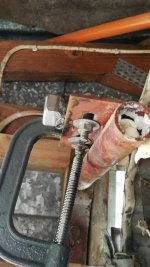
I could not see for the life of me how to tension it back up, so I welded a nut to one end and hauled on a big (24") wrench (dubbed "the nutf***er") while my brother-in-law opened the door gradually. Then wound on the last bit and tightened the u-bolts. Worked a treat, it's actually set better than it was before.
Before anyone comments on my welding... I know, I know [emoji28] but it did the job ¯\_(ツ)_/¯

- Home
- Member Areas
- The Lounge
- What did you last repair?
